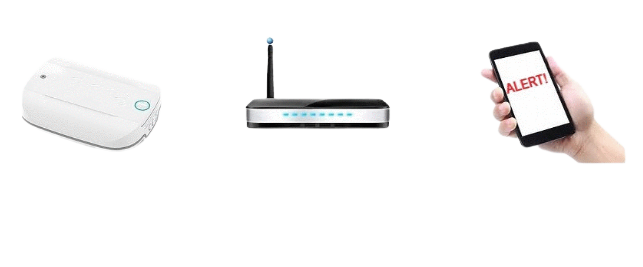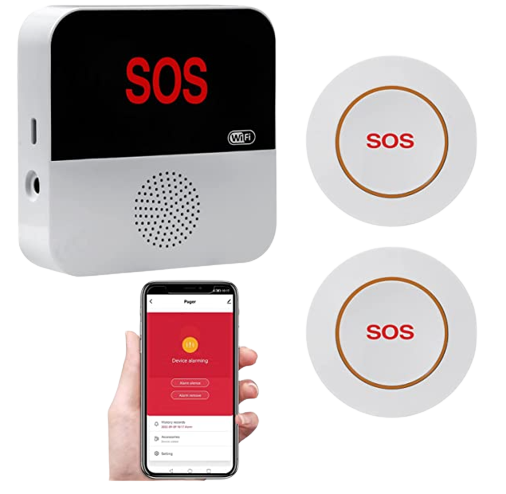In today’s fast-paced world, technology has revolutionized the healthcare industry, bringing numerous advancements that enhance patient care and safety. One such innovation is the wireless medical alert device, a compact and portable gadget designed to provide individuals with quick and reliable access to medical assistance in emergencies.
This article explores the features, benefits, and impact of wireless medical alert devices, shedding light on their role in empowering safety and independence.

What are Wireless Medical Alert Devices?
Wireless medical alert devices, or personal emergency response systems (PERS), are wearable or portable devices equipped with wireless communication capabilities. These devices connect users to a 24/7 monitoring center or designated contacts at the press of a button. When activated, the device establishes a connection through cellular networks or other wireless technologies, allowing individuals to promptly communicate their emergency and receive appropriate assistance.
Features and Design:
Wireless medical alert devices are designed with user convenience and safety in mind. They typically feature a lightweight and discreet design, allowing users to carry them comfortably throughout the day. These devices often come with a range of features, including:
- Emergency Button: The primary function of a medical alert device is its emergency button. Usually located on the device itself or as a wearable pendant, this button can be easily pressed to initiate a call for help.
- Two-Way Communication: Most devices incorporate two-way communication, enabling users to speak directly with a trained operator at the monitoring center. This allows for effective assessment of the situation and appropriate response coordination.
- Fall Detection: Some advanced models use fall detection technology. These devices automatically detect falls and trigger an alert, even if the user cannot press the emergency button. Fall detection is especially crucial for the elderly or individuals with medical conditions prone to falls.
- GPS Tracking: Many wireless medical alert devices incorporate GPS tracking capabilities. This feature enables emergency responders to pinpoint the user’s location accurately, making it easier to provide timely assistance, particularly in outdoor or unfamiliar environments.
Benefits and Impact:
The adoption of wireless medical alert devices brings several significant benefits and impacts:
- Enhanced Safety: Wireless medical alert devices offer users and their loved ones peace of mind. With quick access to help in emergencies, individuals can feel safer and more confident to engage in daily activities, knowing that assistance is just a button press away.
- Prompt Medical Assistance: The ability to communicate directly with a monitoring center ensures rapid access to medical professionals who can assess the situation and dispatch appropriate assistance, whether emergency medical services or contacting designated caregivers.
- Independence and Freedom: Wireless medical alert devices enable individuals to maintain their independence and autonomy. Seniors or people with chronic conditions can continue living in their homes or engaging in outdoor activities, knowing that help is readily available.
- Peace of Mind for Caregivers: Family members or caregivers often worry about the well-being of their loved ones, especially when they are alone. Wireless medical alert devices alleviate these concerns, as caregivers can trust that their loved ones have a reliable way of contacting help.
- Rapid Response in Fall Incidents: Fall detection technology plays a crucial role in minimizing the consequences of falls. In the event of a fall, the device automatically triggers an alert, ensuring that assistance is promptly dispatched. This can be life-saving, especially for individuals who cannot call for help on their own.
- Cost-Effective Solution: Wireless medical alert devices offer a cost-effective alternative to assisted living facilities or constant in-home care. They allow individuals to maintain their independence while providing an added layer of safety.
FAQs:
Who can benefit from using a wireless medical alert device?
Wireless medical alert devices benefit individuals of all ages, especially those who are elderly, have chronic medical conditions or are at a higher risk of falls. They provide peace of mind and quick access to help in emergencies.
Can wireless medical alert devices be used outside the home?
Yes, wireless medical alert devices are designed to be portable, allowing users to carry them wherever they go. They can be used inside and outside the home, providing safety and assistance wherever needed.
Do wireless medical alert devices require a landline phone connection?
No, wireless medical alert devices do not require a landline phone connection. They operate using cellular networks or other wireless technologies, ensuring that users can access help even if they don’t have a landline phone.

How reliable are wireless medical alert devices in emergencies?
Wireless medical alert devices are designed to be highly reliable in emergencies. They establish a fast and secure connection with monitoring centers, allowing for immediate communication and coordination of appropriate assistance.
What happens if a user activates the device accidentally?
If the device is activated accidentally, users can simply inform the operator during the two-way communication. Monitoring center operators are trained to handle such situations and will ensure no unnecessary assistance is dispatched.
Can multiple contacts be programmed into a wireless medical alert device?
Many wireless medical alert devices allow users to program multiple contacts, such as family members, friends, or caregivers. This ensures that others can be reached in an emergency if the primary contact is unavailable.
Does insurance cover wireless medical alert devices?
Some insurance plans may cover the cost of wireless medical alert devices. Checking with the insurance provider to determine coverage options and requirements is recommended.
Can individuals use wireless medical alert devices with hearing or speech impairments?
Yes, individuals with hearing or speech impairments can use wireless medical alert devices. The two-way communication feature allows users to communicate their emergencies, and operators are trained to accommodate different communication needs.
How often should the battery be charged in a wireless medical alert device?
The battery life and charging frequency depend on the specific device model. It is generally recommended to follow the manufacturer’s instructions regarding battery charging to ensure that the device is always ready for use.
Can a wireless medical alert device be used internationally?
The usability of a wireless medical alert device in international locations depends on the device and service provider. It is advisable to check with the manufacturer or service provider regarding international compatibility and coverage options.
Are wireless medical alert devices waterproof?
Many wireless medical alert devices are water-resistant or waterproof, allowing users to wear them in the shower or during daily activities without worrying about water damage. However, the level of water resistance may vary between
Conclusion:
Wireless medical alert devices have emerged as a significant technological advancement in healthcare, empowering individuals to lead independent lives while having peace of mind and rapid access to medical assistance. With their advanced features, portability, and ease of use, these devices have transformed how emergencies are handled, ensuring that help is just a button press away.
As technology evolves, wireless medical alert devices are expected to become even more sophisticated, further enhancing safety and independence for individuals of all ages and medical conditions.
